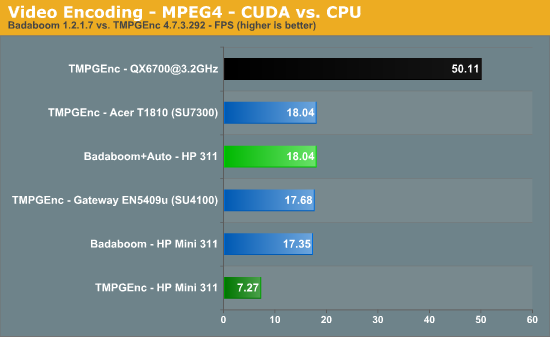HP Mini 311 — CUDA on ION
NVIDIA always likes to tout the advantages of their GPUs and CUDA. In theory, if you have a highly parallelizable task like video encoding/decoding/processing, you can accomplish that task a lot faster on a GPU than on a traditional CPU. When you add in the fact that Atom is already a very slow in-order architecture (albeit with Hyper-Threading), boosting performance of certain tasks could be very beneficial.
One of the applications NVIDIA talks about a lot with relation to CUDA is Badaboom. We haven't looked at in quite some time, and with the low performance of Atom CPUs it might be a viable option. We ran a test encode using Badaboom and a 720p source video, targeting the default "YouTube" output: 640x360 with 1000kbit VBR video and 128kbit MP3 audio. We also tweaked the Badaboom settings to enable auto key frame insertion for improved image quality and performance, which we'll see in a moment.
We can't run Badaboom on CPUs, unfortunately, so we used TMPGEnc 4.0 Xpress and similar settings: MPEG4 1000kbit video with 128kbit AAC audio. Interestingly, TMPGEnc also supports CUDA. However, the encoding is all done on the CPU, so the main benefit of CUDA for TMPGEnc is if you use some of the complex filters like noise reduction and smart sharpen. If you're just doing a straight video encode, CUDA doesn't appear to help TMPGEnc right now.
First up, here are the results, with CPU encoding time on an Acer Timeline 1810 as well as a desktop Core 2 Quad 3.2GHz thrown in for reference.

Badaboom ends up being about 2.5 times faster than doing the video encoding on the Atom N270. Hooray! It's also about the same speed as a Pentium SU4300, but an overclocked Kentsfield 3.2GHz CPU is still 2.8 times as fast. Can you do basic video encoding on the ION LE with Badaboom? Yes, but now let's discuss quality for a moment.
The highest quality encodes will always require multiple passes in order to provide a better analysis of how to best use the available file size. Badaboom doesn't support multiple passes, so we did a single-pass encode in TMPGEnc for comparison. File sizes are similar (4213KB TMPGEnc vs. 4205KB Badaboom). Below are the image captures of the encoded video.

Default Badaboom YouTube setting

Badaboom YouTube setting with Auto Key Frames

TMPGEnc 4.0 Express — Single pass MPEG4 AVC 1000kbit VBR (3000kbit max)
The initial encodes using the Badaboom YouTube defaults are, at times, horrific. The content of the source video (and the scene in particular) can make a big difference, but overall the default settings fail to produce optimal results. Fast motion content is the worst offender, but then doing a good compression of fast action content has always been a lot more difficult. Luckily, we determined that making one change — setting the Key Frame Mode to "Auto" instead of "Fixed" (with the default "Baseline" and not "Main" mode) — results in a much better image. We still give the quality lead to TMPGEnc — and if you do multiple passes, the gap widens — but as a compromise the CUDA-based Badaboom encoder can achieve some decent results. As for ION, it's not really fast enough to make CUDA compelling; a moderate CPU can easily produce better results. Move to a faster GPU (NVIDIA's GTX 260M does the same encode at around 82 FPS and GTX 280M is at 100 FPS) and CUDA can flex its muscles.
There are other concerns with Badaboom, however. We had quite a few sample videos that it wouldn't accept (including a standard MPEG2 video). We also had some issues with audio glitches — our test encoded video has a couple small gaps in the audio, and they're there every single time on multiple systems. It's a relatively easy to use tool, but ultimately it can provide encoding performance at the cost of flexibility and quality.
There are other CUDA applications, of course. We'll look at SimHD DVD up-sampling in our battery life tests for example. Another potentially useful tool is called vReveal, which can remove noise, improve contrast/lighting, and reduce shakiness in recorded videos. If you make videos with your cell phone or inexpensive digicam and you want to upload them to YouTube, vReveal might be worth a purchase. A better video recorder would be an even better purchase, of course.
Most of the CUDA tools at present focus on video (and to a lesser extent image) related activities, since these tend to be highly parallelizable. Anyone doing video editing/encoding work will want something far more powerful than an Atom-based netbook, even if it does have ION to help out. Ultimately, while CUDA is certainly interesting, we prefer a vendor-agnostic approach, and DirectCompute will hopefully provide that in the coming months (or years). We also need to maintain a balanced system — certain tasks still rely heavily on the CPU and aren't candidates for GPU acceleration — and Atom is nowhere near fast enough for a modern computer.










51 Comments
View All Comments
JarredWalton - Sunday, November 22, 2009 - link
I have a Timeline 1810 for review, so I actually have practical hands-on experience. Plus, when you consider the RAM upgrade on the 311, and a few other sundry extras, you quickly get a more realistic base price of $450 to $500.At that point, comparisons with anything from the 1410 (and the Gateway EC 1435u I mentioned) through the $650 Timeline/EC models are all valid. Unfortunately, I don't have the $400 laptops in for review. I can come up with a fairly reasonable idea of how they'll perform, however, and the Celeron SU2300 is by far the best option for a small netbook right now.
QChronoD - Sunday, November 22, 2009 - link
Do you guys run a default calibration on all of the displays before you test them or are those numbers OOTB?JarredWalton - Sunday, November 22, 2009 - link
Those numbers are using ColorEyes Display Pro to calibrate the LCDs. I have tried in the past to come up with an "out of box" result, and either the LCDs are all horrific (typically Delta E will average around 12 to 15), or I'm not doing the test properly. Without a way to be 100% sure what was going on, I decided to just stop doing those tests.Ultimately, I think most users will adapt to however a display looks, unless they're really serious about color quality. When we're looking at netbooks, I think the vast majority of users never really pay attention to the LCDs. Obviously, I do pay some attention, but unless a display is really good I'm not going to spend much time on that area. Right now, most of the laptop LCDs are junk.
hyc - Sunday, November 22, 2009 - link
Amen to that. I find it incredible that vendors are selling 15" displays with only 1366x768 resolution. (While these 11" netbooks have the same resolution.) When I buy a 50% larger screen, I expect 50% more workspace, not 50% larger pixels. WTF...Lord 666 - Sunday, November 22, 2009 - link
I own two HP 311 Mini's (one custom built and other 1037NR from VZW)and one HP 1151NR from VZW and can say the keyboard and touchpad placement were compromised on the 311s from older versions. The smooth keys and angle due to 6 cell make it challenging to type on than the 1151's matte finish and flat bottom. Plus, the left/right mouse buttons on the bottom make it tough to click compared to 1151.However, compared to the older 1151 there are many advantages (screen size, larger stock battery and RAM, easy access to internals) and the reason why I picked up a second HP 311. The HP 1151 is being traded in tomorrow.
fokka - Sunday, November 22, 2009 - link
jarred, you act like an atom limits the performance/experience even in simple day to day applications. i have to admit, i had similar gripes before my gf got her asus 1005hah, but now i learned, that this standard atom-netbook is delivering quite well in everyday tasks.(of course) i had the pleasure to set this thing up installing software etc and i also did a lot of web-browsing and not even in this new youtube 1080p video-sample (fullscreen) i had slow-downs while bettery life was exceptional (8-10h) because i could use the super-power-save mode.
boot and hibernate etc also were much faster than on our standard notebooks (dell vostro c2d).
so while atom is extremely slow in raw numbers compared to other cpus, the everyday tasks of the average user dont suffer from this limitation.
just want to make things clear ;) otherwise excellent review, thanks!
Mint - Sunday, November 22, 2009 - link
Not to mention that for more compute intensive operations (other than games and multimedia authoring) there's always VNC or remote desktop. Works well for a bunch of engineering and scientific software.Netbook+desktop is a very good alternative to a single power notebook, and often comes in cheaper and more portable to boot.
ssj4Gogeta - Monday, November 23, 2009 - link
I bought this dv6-1154tx for INR 67,000 (approx. US $1400) when I joined uni this year. Should have got a $1000 desktop and a $400 netbook instead. Now I'm stuck with this notebook for another couple years or so at least.Lonyo - Sunday, November 22, 2009 - link
I got an Asus 751h with the slower 1.33GHz processor, and apart from being sluggish on Youtube and some other unnecessarily intensive sites, for what I actually use it for, writing papers in the library, it's perfectly functional.Most of the time is spent checking websites for resources, looking at pdfs and using Word 07, and for all those tasks it's fine.
Sure I can't encode stuff, but who would dream of doing that?
JarredWalton - Sunday, November 22, 2009 - link
But have either of you tried something like a Timeline 1810? I have, and I can tell you that the experience is better than Atom -- quite a bit better in many instances. It's not just about raw, CPU intensive performance; the 1810 boots faster (marginally) and loads applications faster. Trying to open a dialog while a video is decoding as one example is horrible on Atom -- better to pause the video first.Basically, Atom *can* do what you need, but so can just about any other CPU currently out there.